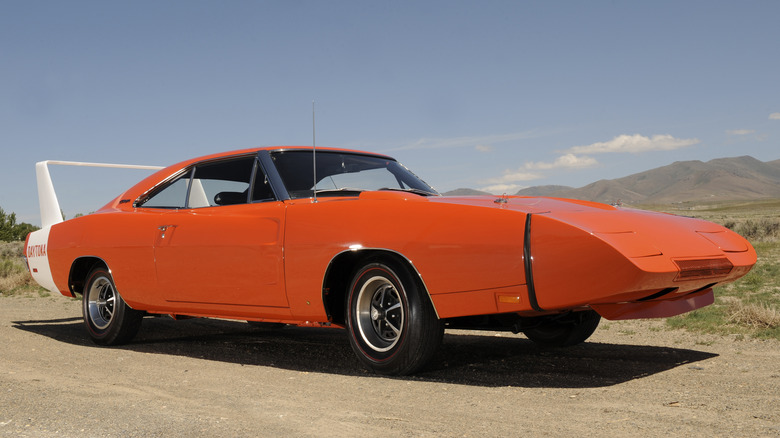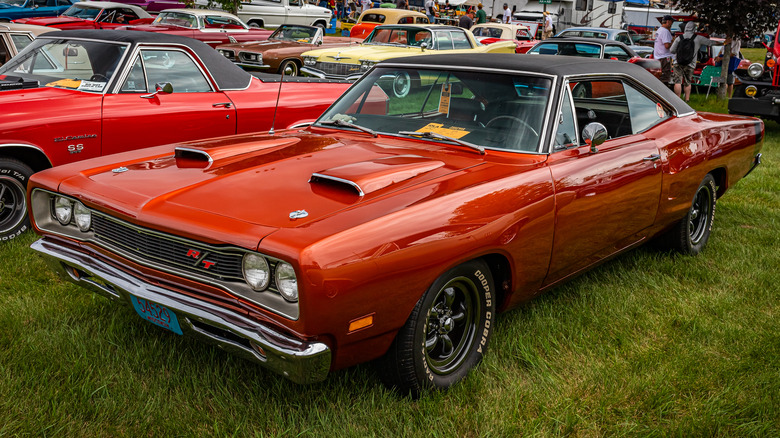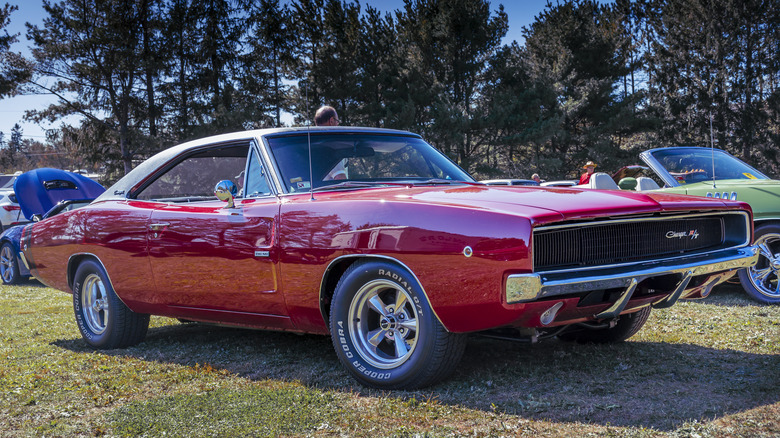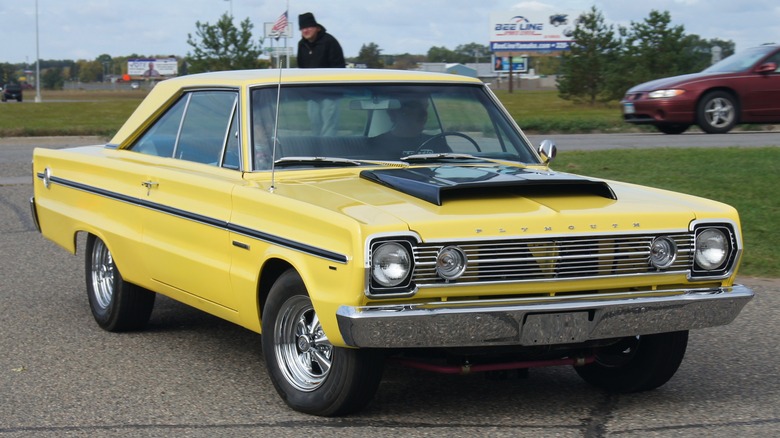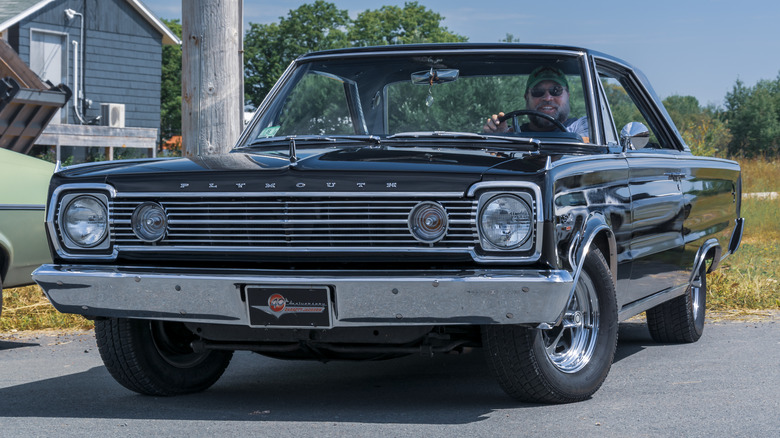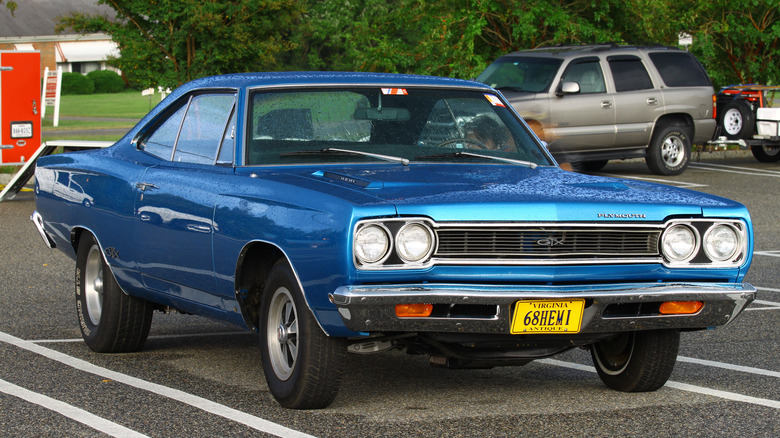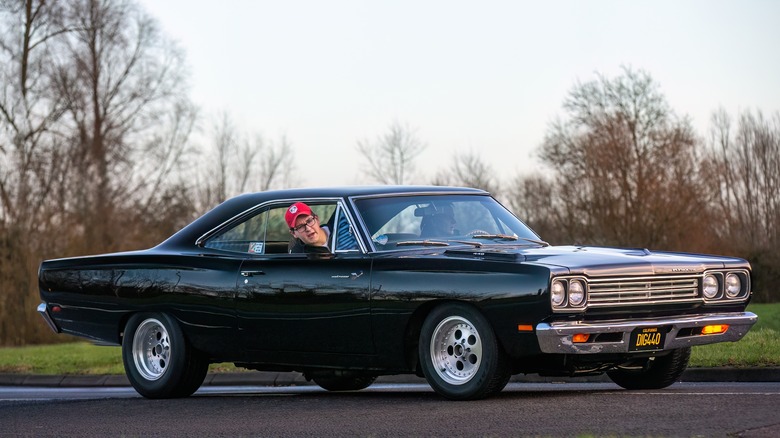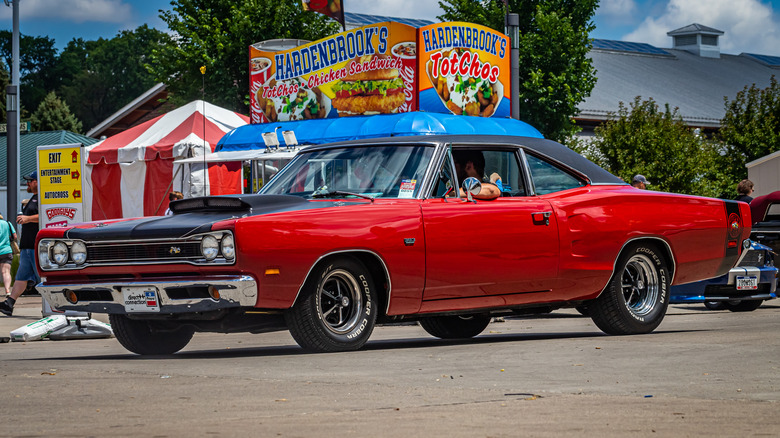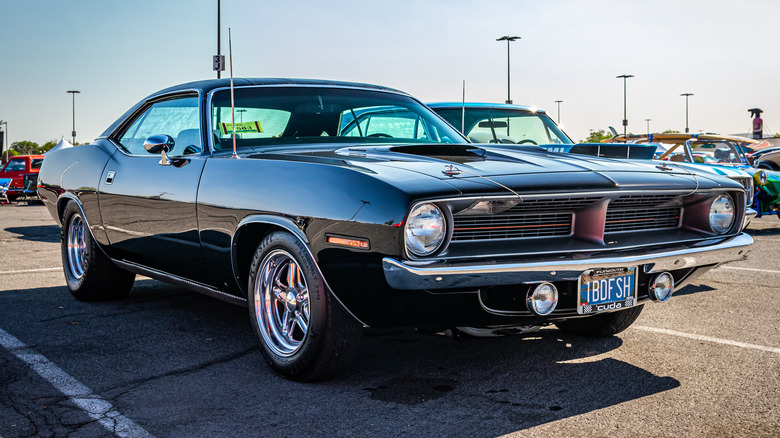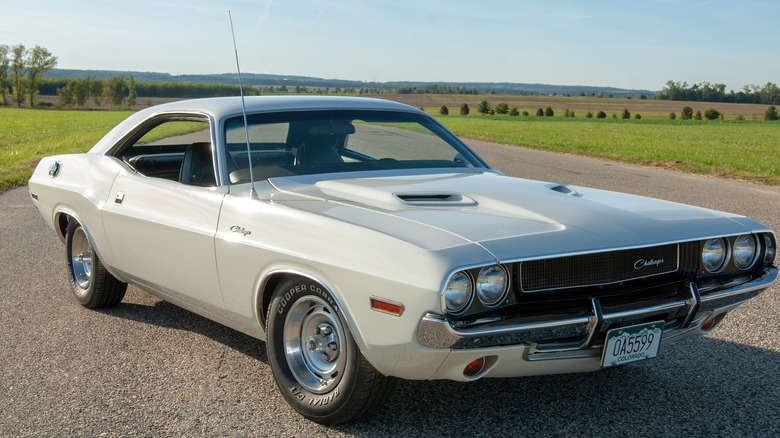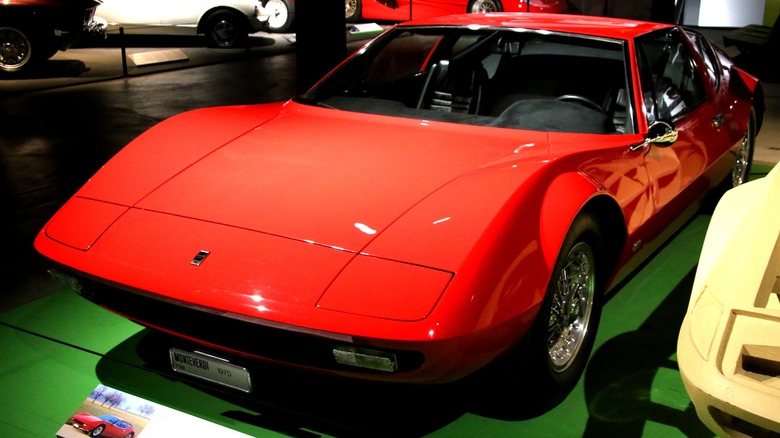Every Car That Used A Street Version Of The 426 Hemi Engine From 1964-1971
In the history of American V8 engines, few have the iconic status and sheer gearhead cachet of Chrysler's 425-hp, 490 lb-ft 426 Hemi V8. But the engine's reputation stands in direct contrast to its popularity with consumers when it was new, with only around 10,000 Street Hemis — the street-going, slightly detuned version of the original 426 Hemi — produced during its six-year production run between 1966 and 1971.
These Hemis ended up in a selection of Chrysler B-Body cars across the Dodge and Plymouth brands, from iconic cars like the Dodge Charger and Challenger to less-prominent names such as the Plymouth Belvedere and Satellite. All in all, 13 Chrysler nameplates were graced with an optional 426 Hemi, although some of these — such as the Satellite — were in reality only separate trim levels for the same model (the Belvedere, in the Satellite's case).
But while the 426 Hemi is indelibly associated with Chrysler pony and muscle cars, it wasn't the only company to use the engine — or, at least, attempt to. The Street Hemi popped up in two European cars in the late 1960s and early 1970s, too, although neither ever made it to market. If you were ever curious about the engine bays the 426 Street Hemi graced in its lifetime, this is the list for you.
Dodge Coronet and Coronet R/T
The Dodge Coronet was one of the first cars to receive the Street Hemi, with the 425-hp V8 available as an optional engine starting in the 1966 model year. Available in four trim levels — base Coronet, Coronet Deluxe, Coronet 440, and Coronet 500 — with either a hard- or soft-top and two- or four-door body styles, this fifth-generation Coronet was an all-new mid-sized car, a notable departure from its full-sized predecessor that ran from 1949 to 1959.
At the start of 1966, the Coronet came with a selection of relatively mundane engines. Powerplant options started with the 145-hp 225 Slant-Six — except on the Coronet 500, which was V8-only — and topped out with the 325-hp 383 V8, one of the best engines to ever grace Mopar muscle cars. It's not exactly clear when Chrysler started offering the 426 Hemi in 1966, but the $907.60 option didn't exactly fly off the shelves. Only 734 Street Hemi-equipped Coronets left the factory that year out of a total production run of more than 200,000 two- and four-door units.
For 1967, Chrysler opted to gatekeep the Street Hemi by limiting it to the Coronet's R/T trim level. The 426 Hemi continued to be available as an option on the Coronet R/T until 1970. A total of 411 Hemi-equipped Coronet R/Ts were built over those four years, after which Chrysler discontinued the two-door Coronet for a few years.
Dodge Charger, Charger R/T, and Charger Daytona
Dodge's Charger debuted in 1966 as a rival to GM's mid-sized muscle cars, such as the Chevrolet Chevelle and Pontiac GTO. It featured a fastback roof grafted onto the existing Coronet platform but was otherwise mechanically similar, right down to the engine choices.
Prospective Charger buyers in 1966 could choose between four V8s: the 318, 361, 383, and the king of the hill, the 426 Street Hemi. As with the Coronet, the Hemi was a pricey option, adding nearly $900 to the Charger's $3,100 base price. Other upgrades that came with the 426 Hemi included an 11-inch clutch, heavy-duty brakes, upgraded suspension, and a Sure-Grip differential — all of which go some way to explaining the huge extra cost.
Unfortunately for Chrysler, the Charger wasn't exactly a hit, with 37,344 units sold in 1966. Of these, only 468 shipped from the factory with the 426 Hemi. Things got even worse in 1967, with only 2,252 Chargers shipping from the factory — 27 of which had a Hemi. 1968 saw the launch of the Charger R/T, but Chrysler only built 1,082 Hemi-equipped models before its discontinuation in 1971.
The 426 Hemi was also an optional engine in the 1969 Dodge Charger Daytona. One of the best Dodge Chargers ever made, the Daytona had outrageous aerodynamics — it was designed to compete in NASCAR, and 503 examples were built to homologate the car for competition. Out of those 500 units, only 70 came with the 426 Hemi.
Plymouth Belvedere
The Street Hemi may be most associated with Dodge's muscle cars, but it wasn't the only Chrysler brand to get some Street Hemi loving when it debuted in 1966. Chrysler also introduced the Street Hemi to the mid-sized Plymouth Belvedere that year. Interestingly, this wasn't the first time buyers could get a Hemi in a Belvedere: Chrysler sold a limited number of Belvederes in 1965 with a Race Hemi-derived 426.
The Street Hemi was unsurprisingly the top-end engine option for the Belvedere, and its 425 hp and 490 lb-ft of torque handily outstripped the second-best 383 Commando V8. 677 Belvederes shipped with the Street Hemi in 1966, with a mere 10 of these being convertibles. This was the only year customers could officially get a Belvedere with a Street Hemi, as Plymouth seemingly stopped offering it in the Belvedere in 1967.
Stock engines for the 1967 Belvedere were the 225-cubic-inch Slant-Six or a 273-cubic-inch V8, with the 318 and 383 — with two- or four-barrel carburetor — still available as options. However, Chrysler reserved the Street Hemi for the then-new GTX trim level. That said, 11 Belvederes allegedly left the factory with the Street Hemi in 1967, some believed to have been special orders from dealers. Plymouth discontinued the Belvedere nameplate in 1970, with the Satellite taking its place for the 1971 model year.
[Image by Greg Gjerdingen via Wikimedia Commons | Cropped and scaled | CC BY 2.0]
Plymouth Satellite
Out of all the Belvedere-derived Mid-Size 5 cars in Plymouth's mid-60s catalog, the Satellite was the longest-lived of them all. Introduced as the top-end Belvedere trim in 1965, the Satellite — and the broadly similar Sport Satellite — was present throughout the decade and even outlasted the Belvedere, receiving a promotion and becoming a standalone model for 1971.
Like the Belvedere, the Satellite was only officially available with the 426 Street Hemi in 1966. The standard engine was a 273-cubic-inch V8 producing a measly 180 hp, with 318, 361, and 383-cubic-inch V8s also available for those seeking more power. However, true speed freaks could opt for the 426 Hemi for around $1,000 — nearly $10,000 in 2024. This $1,000 got owners more than just the engine, with upgrades like a new suspension system and larger police-spec coming with the beefy engine. Given the huge extra cost, it's no surprise that few Satellite buyers opted for the Street Hemi. Only 844 out of more than 30,000 Satellites had a 426, with only 27 of those being convertibles.
By the time 1967 rolled around, Plymouth had seemingly reconsidered its Street Hemi program. While the engine was still available, the company decided to limit it to the Belvedere's higher-end GTX nameplate — echoing Dodge's R/T program for cars like the Coronet and Charger. Plymouth didn't offer the Street Hemi as an option in the Satellite for the rest of the engine's lifespan.
Plymouth GTX
Plymouth seemingly took a page out of Dodge's playbook starting in the 1967 model year, at least as far as the 426 Street Hemi was concerned. Where the 425-hp V8 had been available on the basic Belvedere in 1966, the following year saw the company introduce a brand new trim with exclusive rights to the Street Hemi: the Belvedere GTX.
The GTX boasted several aesthetic and functional changes from the Belvedere. It included a flip-up pit-stop gas cap, red-lined tires, dual hood scoops, and dual chrome exhaust tips. The Belvedere's uprated braking system, heavy-duty suspension, bucket seats, and the 440-cubic-inch V8 all came standard with the GTX, with options like a four-speed manual transmission and the 426 Street Hemi, available at extra cost.
As with most other Chrysler muscle cars, very few Plymouth GTXs shipped with the Street Hemi. One hundred and twenty-five buyers went for the Hemi in 1967 out of a total of 32,378 Satellites sold (Chrysler counted GTXs as Satellites when logging production numbers). 1969 Hemi GTXs were slightly more plentiful — 446 examples — before numbers dipped as overall sales declined, with 1969 and 1970 seeing only 209 and 72 Hemi GTXs, respectively.
1971 saw the debut of an all-new B-body design language, and the GTX came along for the ride — this time, as a variant of the newly promoted Satellite. This was the final year Chrysler offered the Street Hemi in the GTX (or any of its cars), and only 30 examples left the factory.
Plymouth Road Runner and Superbird
The legendary Plymouth Road Runner was the final member of the brand's Mid-Size 5 to debut — a family of Belvedere-based nameplates that included the Belvedere, Satellite, Satellite Sport, and GTX. The Road Runner launched for the 1968 model year as a high-performance, low-cost muscle car offering cheap speed for budding drag racers.
To this end, Chrysler shipped the Road Runner with the 383 V8 as the stock engine option, although performance-minded souls could opt for the 426 Street Hemi for an extra $714 — not quite as dear as on some other Mopar muscle cars, but still a significant premium on the $2,870 base price. The name was a direct reference to the cartoon character — Chrysler licensed the iconic Road Runner character for $50,000 and spent an extra $10,000 to develop the car's signature "Beep Beep" horn.
The first-generation Plymouth Road Runner was a huge hit, with more than 150,000 cars built from 1968 to 1970. Of these, 1,948 came with the 426. The final year of the first-gen Road Runner also saw Plymouth debut its version of the Dodge Charger Daytona — the Superbird was a high-winged NASCAR special designed for competition. Only 1,935 left the factory, with 135 boasting the 426 Hemi.
The 426 was available for a year in the second-generation Road Runner, which debuted in 1971 as a version of the Plymouth Satellite. Only 55 of the 13,664 Road Runners built in 1971 had a 426 Hemi.
Dodge Super Bee
Plymouth struck gold with the its low-buck, minimalist take on the Plymouth Belvedere, so it's no surprise Dodge engineers took inspiration from the Road Runner later that year with the Dodge Super Bee. The Coronet Super Bee, to give it its full name, launched in mid-1968 as a stripped-down version of the two-door Coronet 440. Like the Road Runner, the Super Bee was aimed directly at performance-minded buyers on a budget, with the marketing material highlighting its price advantage compared to the Pontiac GTO. But the two cars shared more than just their target demographic.
The Super Bee, which shipped with upgrades including uprated suspension and handling components, came with the same 383-cubic-inch V8 found in the Road Runner as standard. Like the Road Runner, buyers could also pay a roughly $700 premium on top of the Super Bee's $3,027 starting price to get the 426 Street Hemi under the hood. Only 125 buyers opted for the 425-hp V8, with most perfectly satisfied with the 383's 335 hp and 425 lb-ft of torque.
1969 was the peak year for Hemi-powered Super Bees, with 258 orders. Things slowed down massively in 1970, with only 36 Hemi Super Bees leaving the factory floor. Chrysler revamped its muscle car lineup for 1971, turning all of its mid-sized coupes into Chargers — thus creating the one-year-only Dodge Charger Super Bee. The 426 Hemi was available for that one year, although only 22 buyers chose it.
Plymouth Barracuda
The Plymouth Barracuda is one of the longest-lived nameplates on our list. It debuted in 1964 and essentially kickstarted the pony car segment, beating Ford's Mustang to market by around two weeks. Unfortunately, the first-generation Barracuda wasn't particularly powerful, with the highest-end engine option — a 273-cubic-inch V8 — only making 180 hp and 260 lb-ft of torque.
Thankfully, Plymouth got with the times and, over the rest of the decade, made higher-power engines such as the 300-hp 383 V8 available. For whatever reason, though, Plymouth never offered the 426 Street Hemi in the Barracuda in the 1960s, even as its Mopar siblings were all tearing streets up with the Hemi's 425 hp. Sure, there was the B029 Super Stock, but that used the Race Hemi.
Mopar fans had to wait until the next decade to finally get a Street Hemi in their Barracuda. Plymouth debuted an all-new Barracuda in 1970. Built on the new E-body platform, the 1970 Barracuda had a larger engine bay that could finally accommodate the big 426-cubic-inch Hemi. Plymouth launched three trim levels that year, with the 426 only available on the highest-end Barracuda variant alongside the 440 Super Commando V8.
The Hemi was only available in the car in 1970 and 1971, with 666 and 115 Hemi 'Cudas shipping each year. The Barracuda — and the 'Cuda — continued into 1972 with the Mopar 340-cubic-inch V8 as the premium engine option, before Chrysler killed the nameplate when it cancelled the 1975 Barracuda.
Dodge Challenger
Dodge's Challenger was a late-comer to the pony car market, debuting in 1970 alongside the redesigned Plymouth Barracuda. Like the Plymouth, the Dodge Challenger was an E-body car, but it was longer and wider than its sibling despite the similar styling.
Two Challenger models debuted in 1970: the standard Challenger and the R/T, with coupe and convertible versions available. Dodge also sold a two-door hardtop SE with leather seat facings and a vinyl roof. Dodge offered a whole host of engines for the 1970 model year, starting with the 225 Slant-Six and going up to 440 Six Pack and 426 Street Hemi engines. Dodge retained a similar engine lineup for the 1971 Challenger, although the standard (non-Six Pack) 440 was no longer an option, with an even lower-end 198-cubic-inch Slant-Six engine available for ultra-thrifty buyers.
Like the Barracuda, the Challenger wasn't particularly successful. Chrysler built roughly 110,000 Challengers during its first couple of Hemi-equipped years; out of those, only 427 were optioned with the Street Hemi — 356 in 1970 and 71 in 1971. The Challenger held on until 1973, but the 318-cubic-inch V8 that was standard by the end of its first-generation run was a far cry from the Street Hemi available during its first couple of years.
Unlike most of the names on our list, though, the Challenger would return. Chrysler resurrected the nameplate in 2009 with a Hemi in the engine bay, kickstarting over a decade's worth of high-powered modern Mopar muscle.
The ones that didn't make it
Chrysler's 426 Hemi is as American as engines get, but that didn't stop a couple of European companies from trying to build Hemi-powered vehicles. First up is U.K.-based Jensen, likely best remembered for its Jensen Interceptor and FF — the latter a four-wheel-drive version of the former. Both cars came with Chrysler's classic 383 V8, although Jensen also built special Interceptor SP models with the higher-power 440 Six Pack engine.
However, Jensen collaborated with GKN to build a single experimental FF with a 426 Hemi, resulting in 1972's FFF-100. This ultra-special Interceptor boasted a custom-built 426 Hemi that had an 11.5:1 compression ratio — higher than the Street Hemi's 10.25:1, but lower than the race Hemi's 12.5:1 — and made 600 hp and 560 lb-ft of torque. The FFF-100 set records on the test track but was more of a proof-of-concept, with GKN abandoning the project soon after the successful tests.
Swiss company Monteverdi was a bit more ambitious with the mid-engined, Street Hemi-powered Hai 450 SS. The 450 SS debuted at the 1970 Geneva Auto Show, with Monteverdi claiming a 4.8-second 0-62 mph time and a 180-mph top speed. Despite these impressive numbers, the car didn't generate much excitement, and Monteverdi didn't receive a single order. The manufacturer only built two prototypes: The first sold and ended up in Germany, while the second could be seen at the Monteverdi Museum in Binningen until it closed in 2016.
[Image by kitmasterbloke via Wikimedia Commons | Cropped and scaled | CC BY 2.0]
